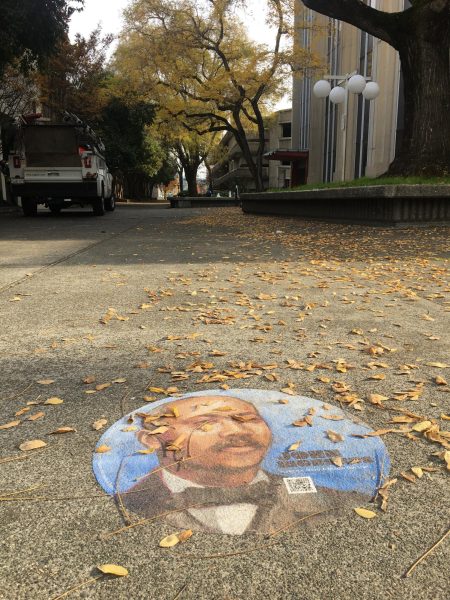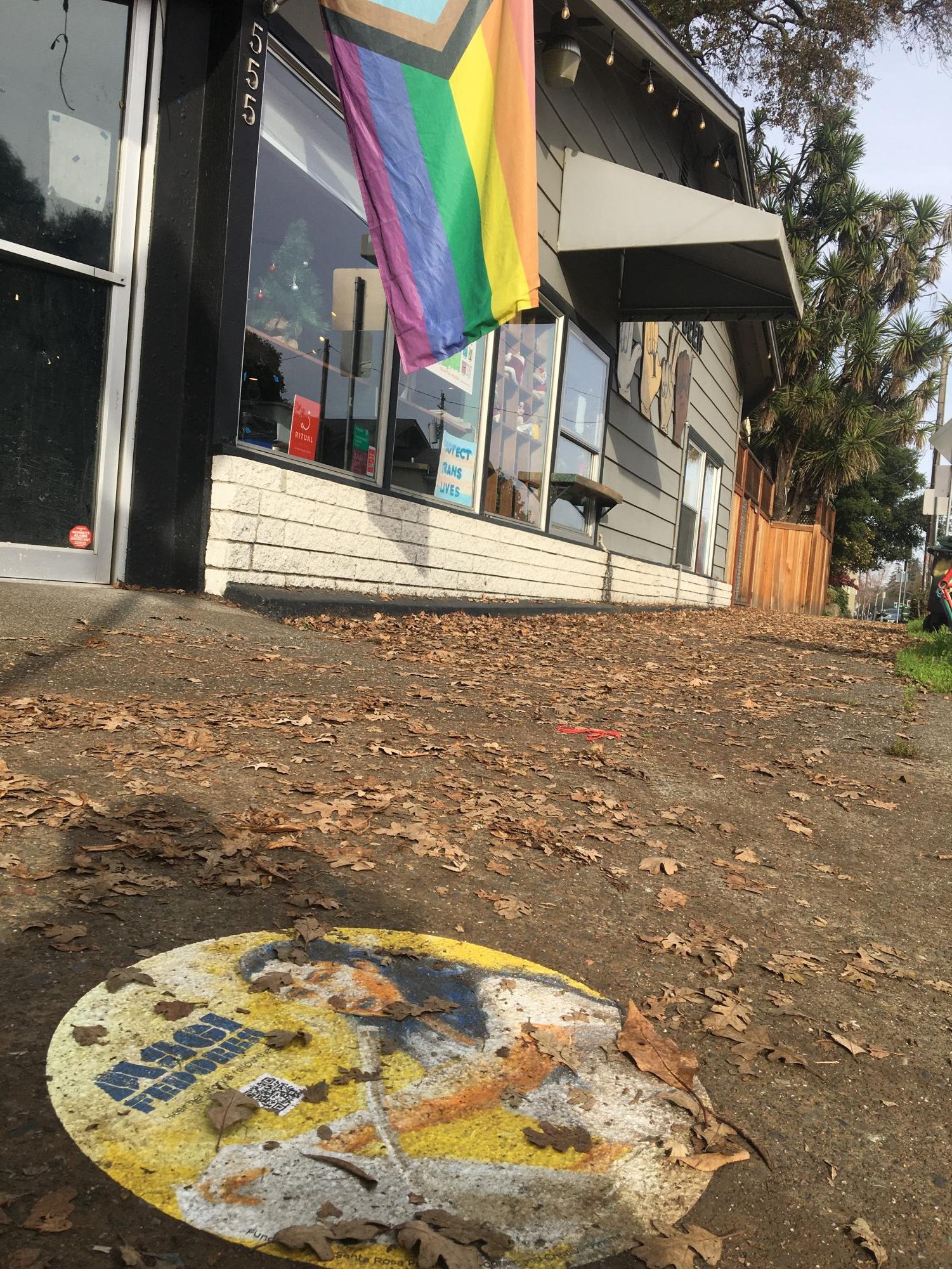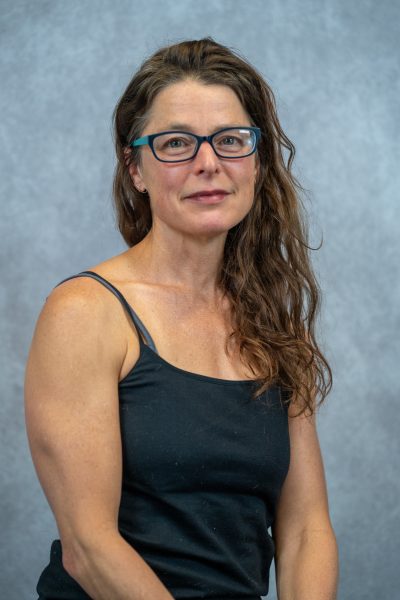Kristen Throop wanted to change the way Santa Rosans view their city. So she changed the cityscape itself.
Throop, a Santa Rosa artist, created 14 portraits of local activists and installed them on sidewalks throughout the downtown area.
The portraits are larger than a dinner plate and fixed to the sidewalk, like Hollywood’s famous Walk of Fame. Instead of entertainers, Throop’s portraits star local activists: lesser-known individuals whose contributions improved the lives of hundreds of community members across nearly two centuries.
On Oct. 29, 2023 over 100 people gathered at the Central Library for the public launch of the project. Throop led several dozen people on the art walk after the opening ceremony, which featured one activist’s daughter. The portraits will remain on the sidewalks for at least one year, Throop said.
“This is really something that tells stories about what it’s like to be part of this community and what it’s like to be on the outskirts, you know, on the edges of the community,” said Throop about her project “Claiming Justice: On the Trail of Local Stories.”
Locals can find a map that shows the location of each portrait on Throop’s website. Or, they can simply start at the Central Library in Santa Rosa and wander through downtown to encounter the portraits as they eat, shop or work. A QR code accompanies each portrait so viewers can access an audio-recording or written biography of the activist’s life.
Fittingly, the project took shape as Throop walked.
“I’ve spent a lot of the last seven years doing a lot of walking. I think I’ve actually walked 11,000 miles,” Throop said. On these walks, Throop “spent a lot of time thinking about what kinds of larger issues we face as a community.”
In particular, Throop wondered how, as a society, we address issues like social justice in meaningful ways. Throop wanted to engage the broader community, but “online discussions tend not to be very deep or very thoughtful,” she said.
In the aftermath of the 2020 murder of George Floyd, the Santa Rosa Junior College Black Student Union shared a piece about Santa Rosa history by D’Mitra Smith entitled “Wine Country’s Racist Past,” and wondered “why we weren’t asking questions,” Throop said. She didn’t have answers to those questions either, and that inspired her to seek the stories of local activists and to tell them. She found inspiration in the Multicultural Roots Project, which the city began in 2020 in response to voices calling for inclusion and representation in Santa Rosa.
The Multicultural Roots Project sought to amplify the lives of local Black, Indigenous, and other people of color and solicited community input for the names of people to showcase on the city’s website. Unfortunately, due to staffing problems, the project ended in 2022. For Throop, however, the early website biographies provided her with a rich resource of locals to research.
Throop began her project with a specific structure but, as she researched, the project itself changed. “I started finding activists,” she said, “and I really liked working with activists because they’re not just doing it because it improves their immediate lives [but] because they’re thinking of a larger group in the community.” She realized that not only was this the story that she wanted to hear, but that this “was the story that other people would need to hear.” And because “I was not running for office, I had a lot of freedom,” she said.
Throop did not want to tell the polished stories that appear in local newspapers and museums. “I didn’t want to do vineyards, I didn’t want to do developers,” she said. She wanted to do something else — “to tell the stories with the rough edges left on.”
Throop spent over a year researching her subjects and interviewing their friends and families. She filled thick binders with over eight pounds of notes. She drew multiple sketches and drafts of each subject. As she created, she rarely listened to music so that she could hear the stories reverberate in her mind as she worked.
Creating art is rarely an isolated act. Throop enlisted the help of local high school students to uncover the truth about John Richards (1824-1879) who owned multiple businesses in downtown Santa Rosa. Richards advocated for the rights of Black Americans and contributed to two Black newspapers: The Pacific Appeal and The Elevator.

Until 1874, California law prevented Native Americans and Blacks from attending school. Richards hired teachers to ensure his children and other Black children in an era when many white Santa Rosans sympathized with the Confederacy. In 1872, Richards and others petitioned the State Supreme Court to provide schooling for children of all races.
Throop placed the portrait of Richards at the site of his barbershop and bathhouse in the sidewalk at the Comstock Mall, across from the Transit Mall. Richards straddled multiple cultures and eras. He was born a slave in Hopkinsville, KY, where he was enslaved. As a young man, he traveled to and worked in Canada, Massachusetts, Missouri, Canada and Michigan before settling in Santa Rosa in 1856.
Evelyn Cheatham, 1953-2019, is another local activist who inspired Throop. Cheatham founded Worth Our Weight, a café where she trained local youth who were homeless or in the foster care system with practical food-service skills for free. But Cheatham offered more than just job skills. She even bought a house next to the café, to create a home for her young employees. “Evelyn brought her heart to every table,” Throop said.
Superlatives gush from the mouths of Cheatham’s former students when describing her. “Fantastic, amazing, and so real,” said Yna Bollock, an SRJC Culinary Arts Program graduate. “She always integrated real-life aspects to prepare her students to enter the culinary world,” Bollock said. Bollock remembers how Cheatham had students prepare lunch for their late-afternoon classes. “It was very important to her that we were taken care of,” she said.
In the process of researching Cheatham, Throop discovered that the café owner, youth advocate and Santa Rosa Junior College culinary arts instructor had also been a member of the Black Panthers. Cheatham, who was interviewed by the Press Democrat in 2014, had not spoken about her relationship with the Black Panthers. Throop did not feel comfortable disclosing this without the blessing of Cheatham’s close family and friends. Cheatham’s daughter and friends enthusiastically told her, “Yes, we want you to really tell that story,” Throop said. “That was an honor and a responsibility at the same time.”
To Joni Davis, an SRJC instructor in the Culinary Arts program, Cheatham was “authentic.” Cheatham taught Davis knife skills but more importantly, that culinary arts are more than just being a chef. She connected with her diverse students “by sharing her story … her truth,” Davis said.
A portrait of Mei Takaya Nakano (1924-2017) sits at the base of the “Plum Tree” statue in the downtown Square. A high school senior when Japan bombed Pearl Harbor, Nakano was sent to the Amache concentration camp in the Colorado desert for incarcerated Japanese Americans. Her new husband was conscripted by the U.S. military to serve in the Military Intelligence Service. Long after the war, the couple raised three children.
At 44, Nakano completed her education, earning a bachelor’s and then a master’s in literature at 50. She co-produced a show at the Oakland Museum of Art about Japanese American Women from 1890-1990 as a counter-narrative to a Smithsonian exhibit glorifying Japanese American men incarcerated in camps who then chose to serve in the military. Nakano later started an anti-Asian hate crime workshop in Sonoma County and served as the first chair for the Sonoma County Commission on Civil Rights.
Throop faced challenges with her project, such as where to install the portraits. “People were not thrilled to have an art piece out, you know,” she said. As a public art installation, the portraits are vulnerable not only to time and weather, but also to negative feedback. “The only markers that have been stolen or defaced are of people of color,” Throop said.
Throop wants these stories to remain amplified. “I would love to have it be a permanent installation and not have it be as vulnerable as it is,” she said. Throop had conversations with the city about creating permanent installations, but “because of the realities of what they’re coping with, in terms of funding, that conversation hasn’t gone anywhere right now,” she said.
Throop thinks this is part of a larger pattern in Santa Rosa.
The 2020 murder of George Floyd led Santa Rosa, like many cities across the United States, to establish diversity, equity, and inclusion agendas and departments. The city created a Community Engagement Department and staffed it with a director, Danielle Garduõ, and two Volunteers in Service to America (VISTA) employees. For a short while, the department produced the Multicultural Roots Project, before coming to a halt in October 2022.
But it’s not just that the project has stalled. “The city is burying the Multicultural Roots links,” Throop said. “There’s a pattern to how things happen in Santa Rosa and that tends to be kind of a little bit passive aggressive. So when you think about the multicultural Roots project, that is getting shoved further and further and further down the website hierarchy … That’s not accidental,” she said.
Someone looking for the biographies will not find them on the city’s Multicultural Roots Project webpage. Searching for “Multicultural Roots Project” on the city’s webpage does not lead to the biographies either. To reach the Multicultural Roots biographies, viewers must first know that the biographies are now located on the city’s blog.
City employee Danielle Garduño, who managed the project before transferring to another department, explained that understaffing resulted in no further development of the project.
For now, Throop focuses on how the project changed her experience with Santa Rosa for the better. “I really loved telling the stories that I didn’t feel had been told as much,” she said.
She believes her role is to bear witness to the stories, even if the truths she brings up are not comfortable things to say. “And I’m sure that there are people who would feel uncomfortable hearing them, but I think that I tried to be as true to the experience of the people that I was representing as I could.”
Chronological Summaries of the Activists
John Richards (1824-1879)
John Richards owned a barbershop, bathhouse and laundry in Santa Rosa in the 1850s. He paid school fees for African American children in town. He also participated in Colored Citizen Conventions and contributed to two African American newspapers: The Pacific Appeal and The Elevator. He advocated for education, employment and legal justice for African Americans and served as the state delegate to the Colored Citizen Convention of California.
Gilbert Gray (1916-1997) and Platt Williams (1928-2014)
Gray and Williams founded the local chapter of the National Association for the Advancement of Colored People and were leaders in the African American community in Santa Rosa.
Mei Takaya Nakano (1924-2017)
An author and activist, Mei Nakano wrote and spoke about incarceration as a Japanese American during World War II.
Bill (1927-2014) and Lucy Kortum (1928-2022).
The Kortums founded environmental and political organizations, and mentored local environmentalists. They advocated for preservation and public access to the coast.
George Ortiz (1934-2020)
Ortiz co-founded Latinos Unidos in 1965, along with California Human Development and other organizations. In its first year, Latinos Unidos gave five $100 scholarships to Latino kids. Over fifty years later, the organization gives out over 1,500 scholarships worth over a million dollars. He organized with Cesar Chavez and United Farm Workers in the 1960s. He believed in nonviolent activism, held hunger strikes and led legal action, boycotts and marches. Ortiz participated in Chavez’s march from Delano to Sacramento and brought buses of Sonoma County farm workers to join the 1,500 marchers.
Anthony Tusler (born 1947)
A disability rights activist, Tusler co-founded the Disabled Student Coalition with Steve Diaz in 1967 at Sonoma State University. He documented the 1977 “504 Sit-in” protest at San Francisco Federal Building. The 26-day long protest demanded the Federal government sign into law Section 504 of the 1973 Rehabilitation Act. Section 504 protected people with disabilities from discrimination and was signed into law in May 1977.
Henry Kaku (born 1948)
Kaku speaks openly about his family’s incarceration at Tule Lake during World War II. He teaches origami and Judo and offers free self-defense classes for Asian Americans.
Charlie Toledo (born 1950)
A midwife, activist and executive chair of Suscol Intertribal Council since 1992, Toledo works to build unity and preservation of Native American culture.
Evelyn Cheatham (1953-2019)
Cheatham founded Worth Our Weight, a café that taught professional culinary skills to about 500 young adults who would benefit from free, professional development. Cheatham taught in the SRJC Culinary Arts program and served annual community dinners.
Magi Fedorka (born 1958)
Fedorka teaches and advocates for LGBTQ-rights. She was elected President of the Sonoma County Democratic Central Committee and presented the Pride Resolution before Sonoma County Supervisors in 1990. She teaches Health Services at SRJC and Mendocino College.
Vince Harper (1966-2021)
Harper advocated for social and economic justice. He was Director of Community Engagement at Community Action Partnership where he worked for 32 years.
Bernice Espinoza (born 1981)
Poet and civil rights attorney, Espinoza provides free legal counsel to people in deportation proceedings.






Cathy Burgett • Apr 25, 2024 at 8:02 am
Thanks for this piece, Amy!
The exhibit is really wonderful. I hope it will become a permanent part of Santa Rosa’s history-telling landscape.